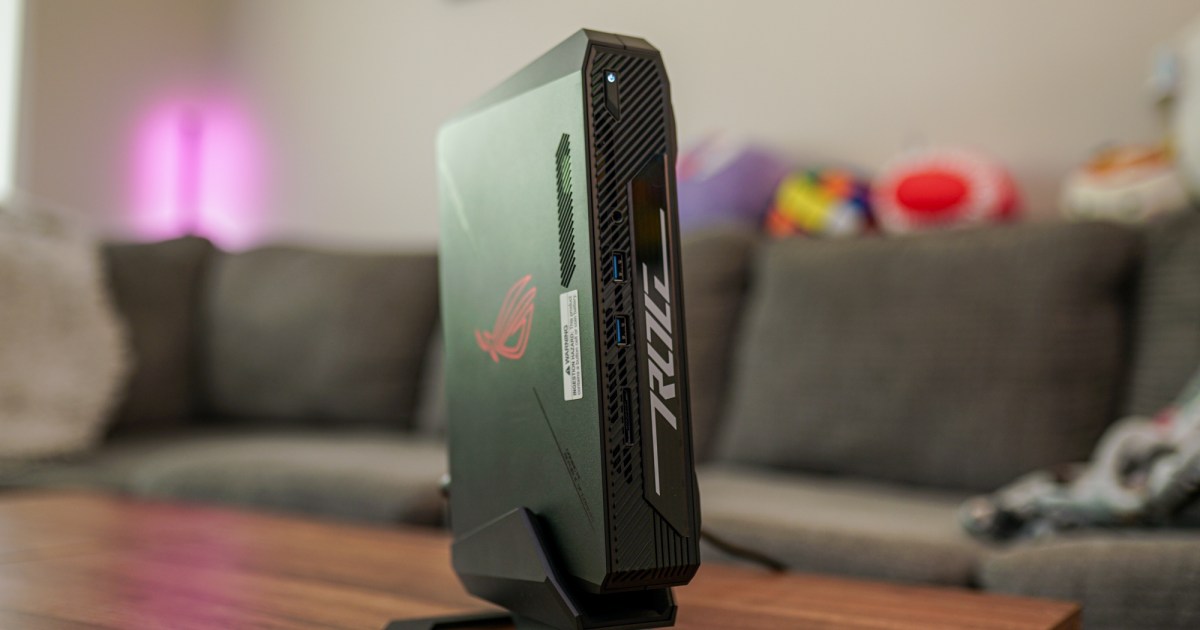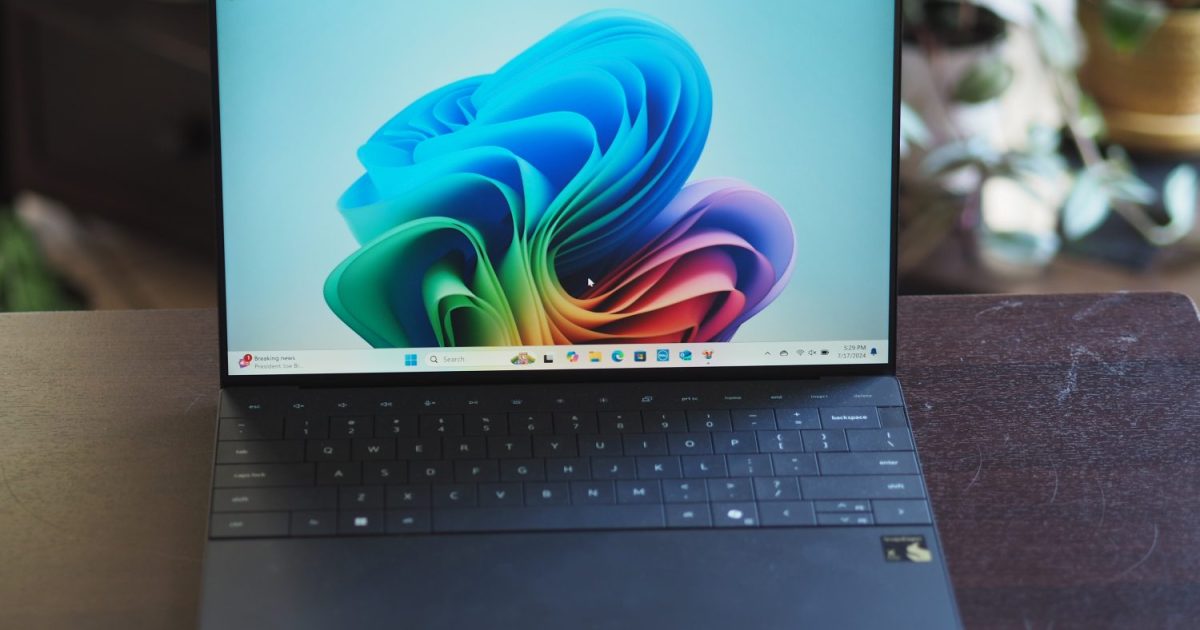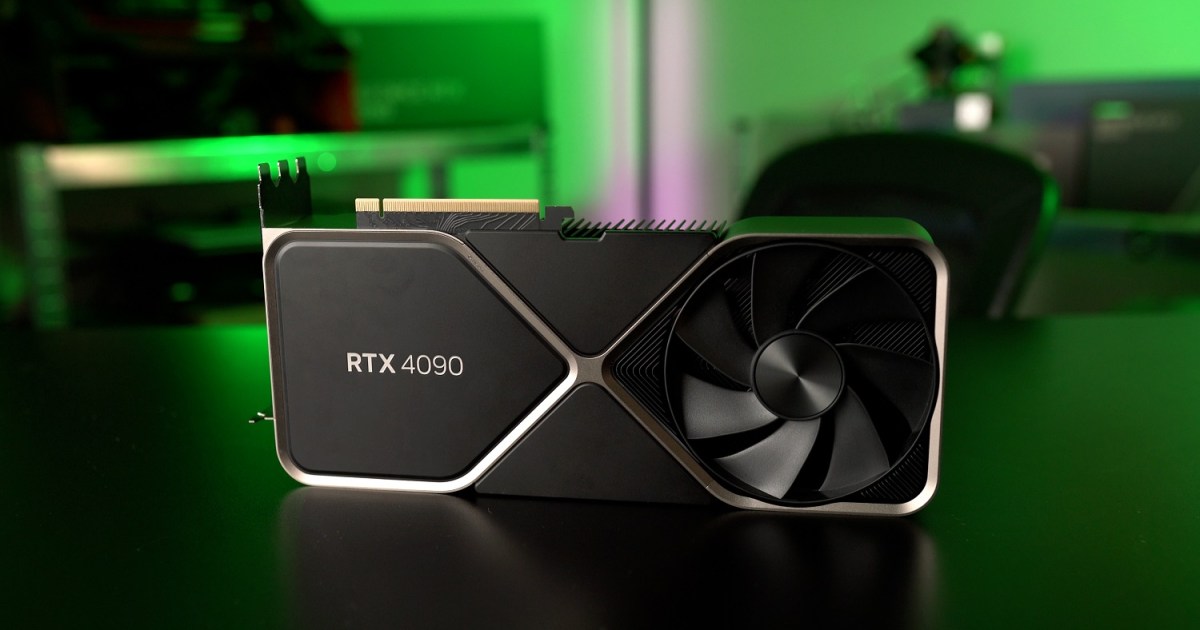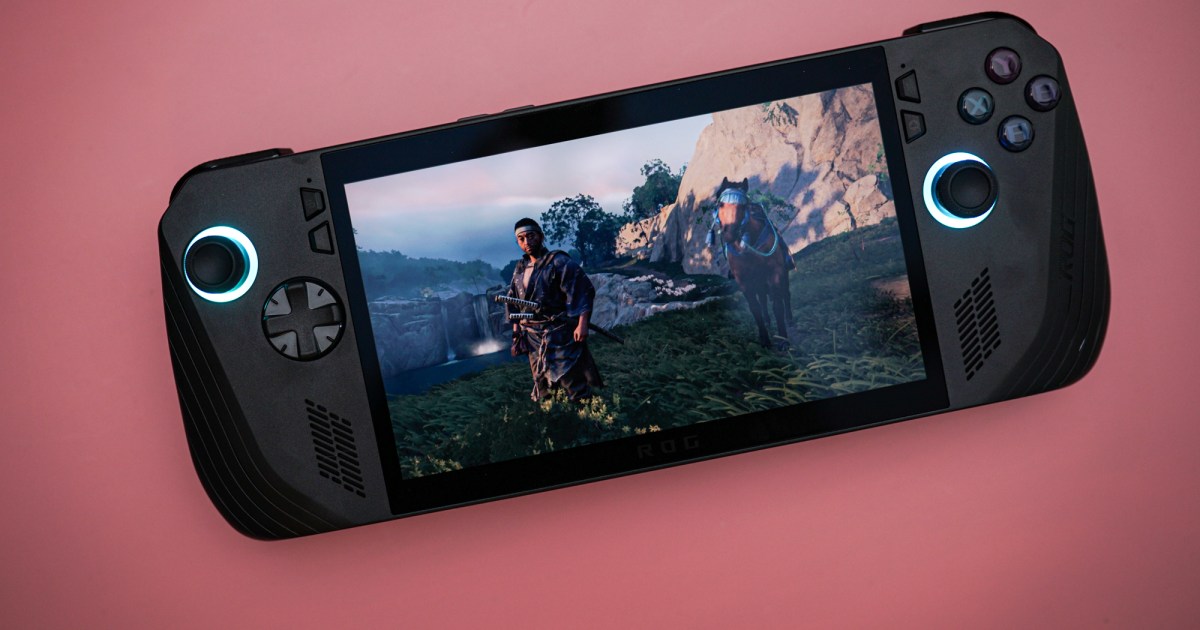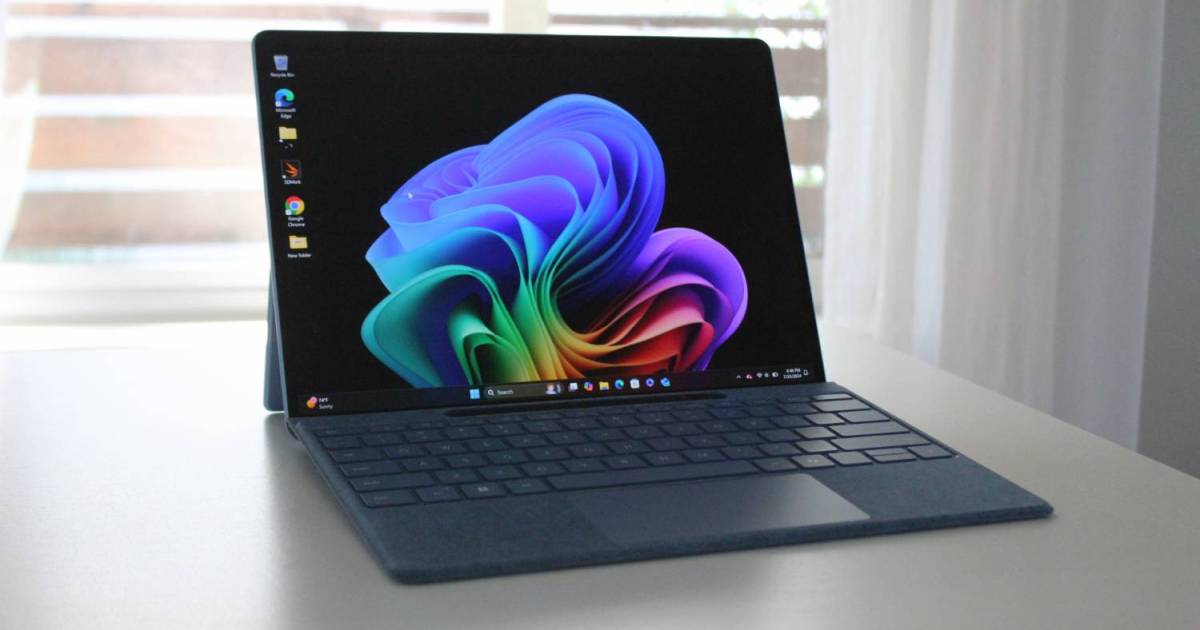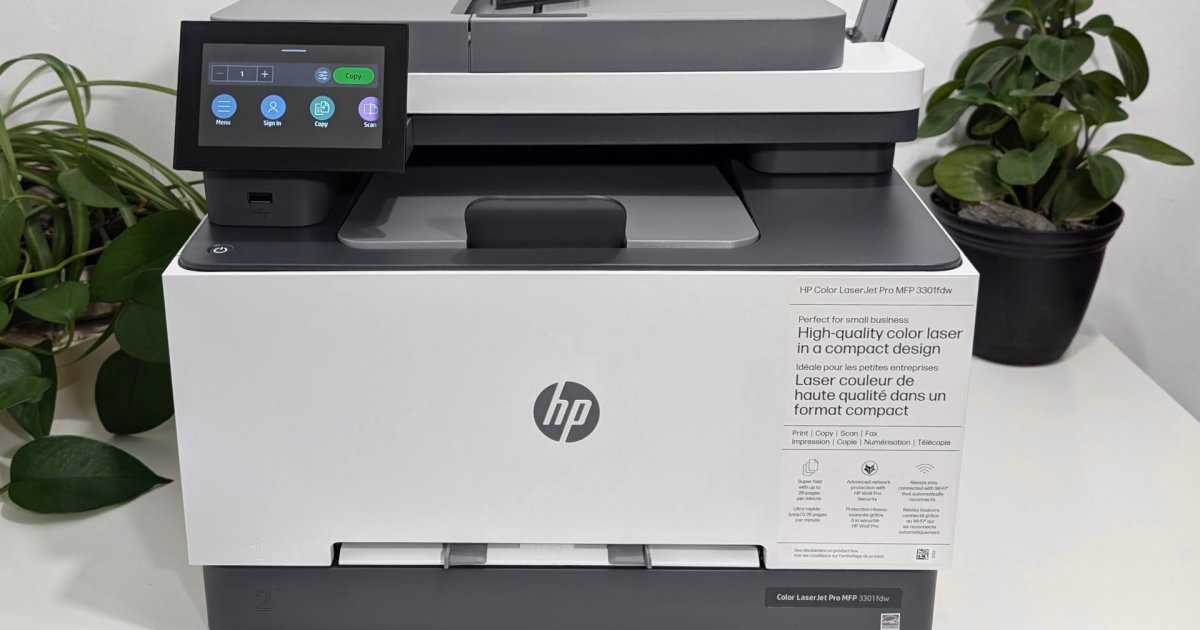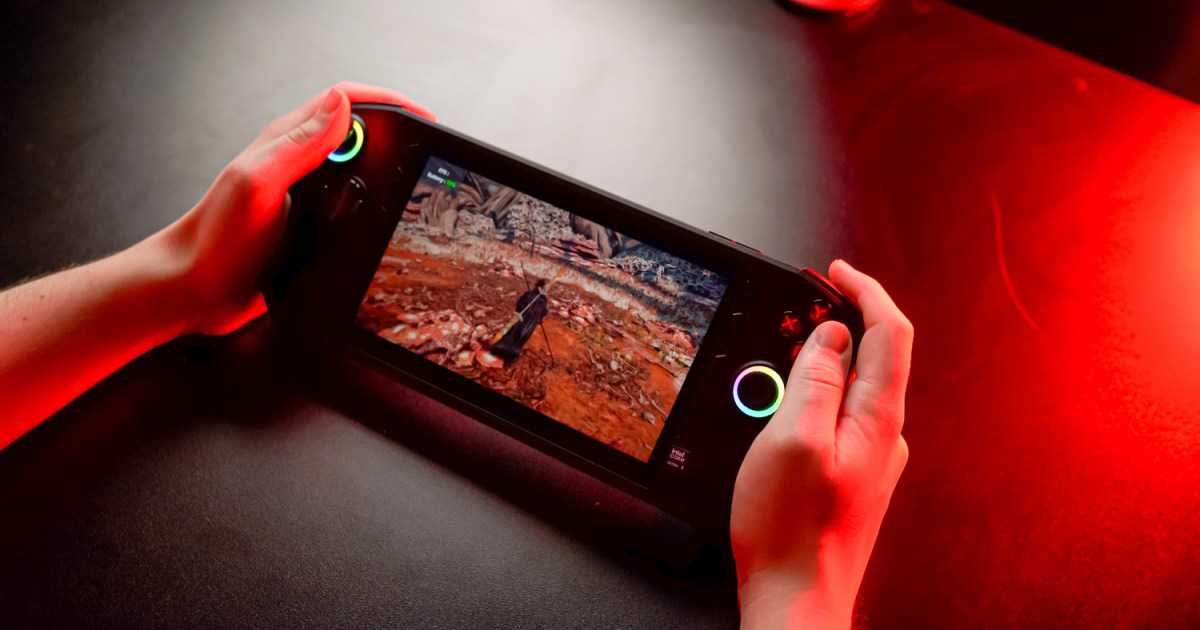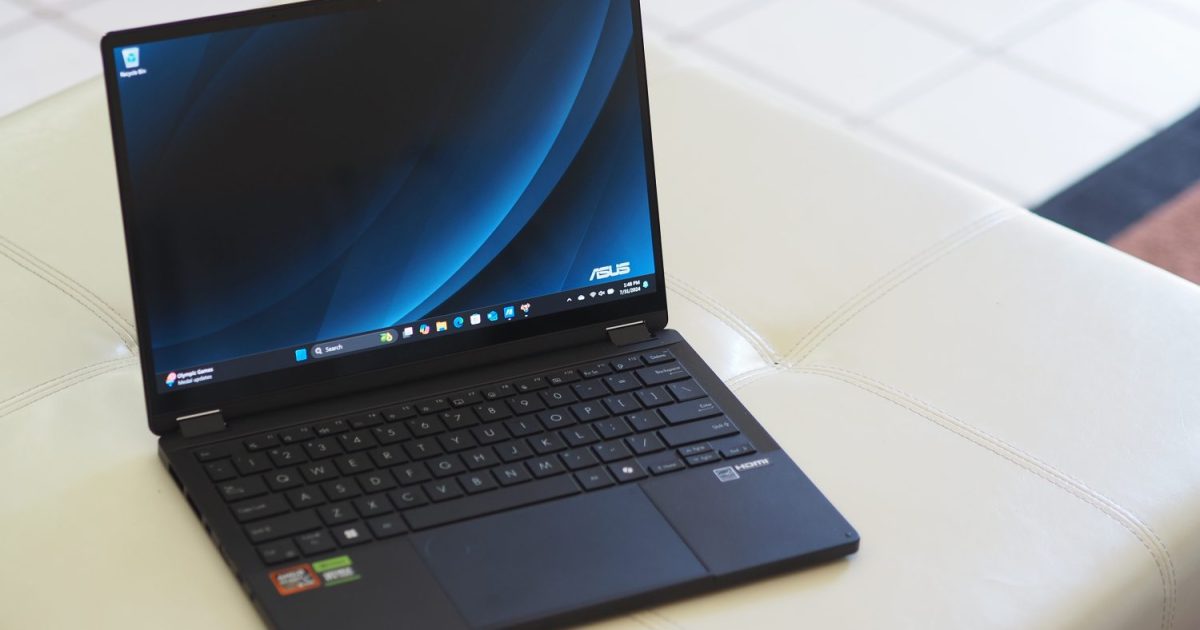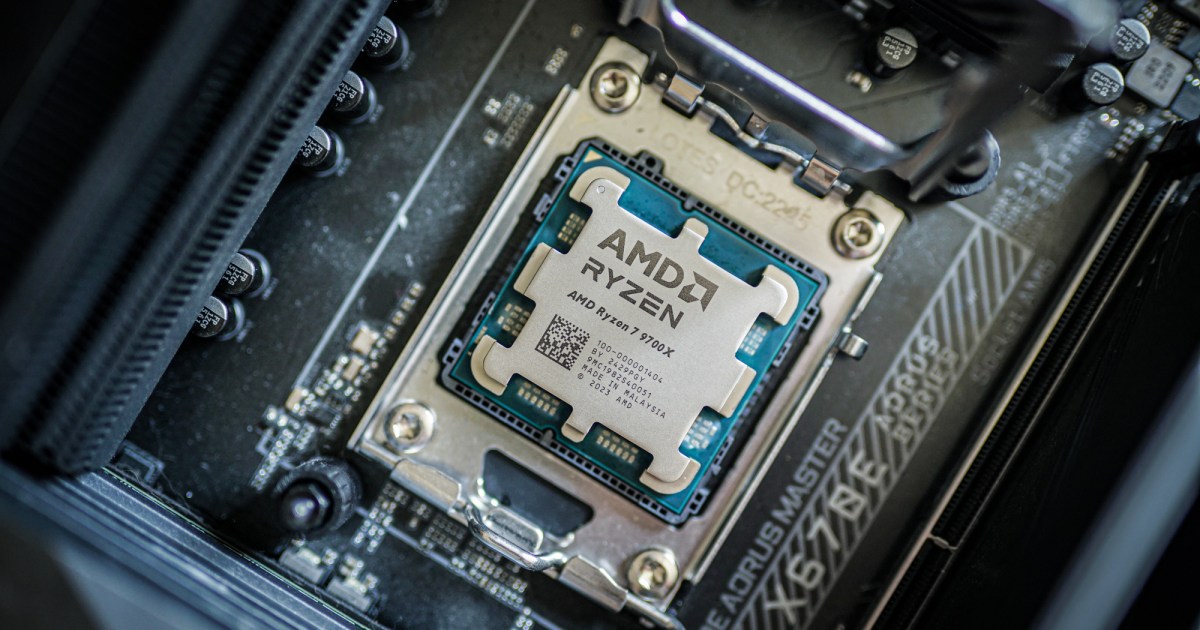The Asus ROG NUC 970 marks a new chapter for Intel’s NUC line. Following Intel’s departure from the NUC market last year, Asus took the reins, and the ROG NUC 970 is the first gaming-focused product to emerge from this partnership. As the ROG branding suggests, this compact PC packs a discrete GPU and a higher price tag compared to mainstream NUCs. With its incredibly small 2.5-liter chassis, the ROG NUC 970 is arguably one of the most compact gaming desktops available. However, its size can be deceiving. While it delivers impressive performance for its hardware, it’s essential to remember that this hardware is derived from laptops, impacting overall power.
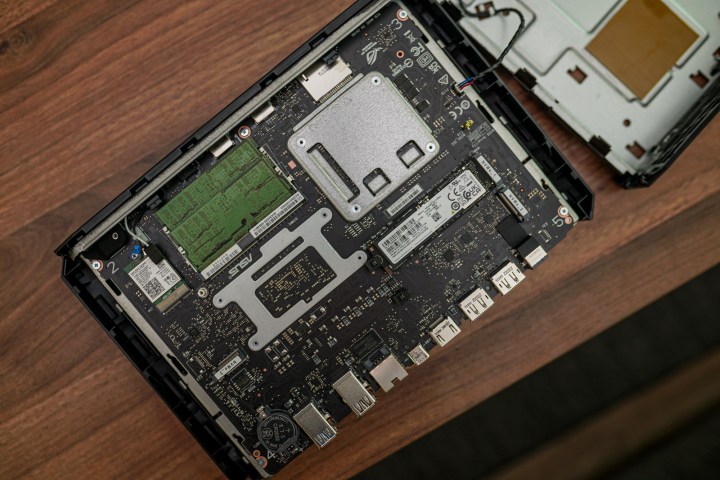 The internals of the Asus ROG NUC 970.Internal components of the Asus ROG NUC 970.
The internals of the Asus ROG NUC 970.Internal components of the Asus ROG NUC 970.
Asus ROG NUC 970 Specifications and Pricing
Asus offers two configurations for the NUC 970, differing in CPU, GPU, memory, and storage. The latter two are less critical as the NUC 970 provides three NVMe slots for storage expansion and two SODIMM slots for memory upgrades. Asus ships the device with dual-channel memory, meaning both slots are populated. Therefore, upgrading requires replacing both modules.
The key differences lie in the CPU and GPU. The base model, priced at $1,629, features an Intel Core Ultra 7 155H processor and an RTX 4060. The higher-end configuration, at $2,199, boasts an RTX 4070 and a Core Ultra 9 185H. Regarding storage and memory, the base model comes with 16GB of RAM and a 512GB SSD, while the premium model offers 32GB of RAM and a 1TB SSD.
My review unit was equipped with the RTX 4070, which seems to be the more readily available configuration. While currently out of stock, most retailers appear to prioritize the RTX 4070 model over the RTX 4060 variant.
| Feature | Asus ROG NUC 970 |
|---|---|
| CPU | Intel Core Ultra 9 185H |
| GPU | Nvidia RTX 4070 Mobile |
| Storage | 1TB NVMe SSD |
| Memory | 32GB DDR5 SODIMM |
| Networking | 2.5G Ethernet, Wi-Fi 6E, Bluetooth 5.3 |
| USB Ports | 2x USB 2.0, 4x USB 3.2 Gen 2 Type-A, 1x Thunderbolt 4 |
| List Price | $2,200 |
Compared to full-sized desktops, the ROG NUC 970’s pricing seems reasonable. For instance, a Starforge Systems Navigator with an RTX 4070 and Ryzen 5 7600X costs $1,900, and an Alienware Aurora R16 with an RTX 4070 and Core i9-13900F is priced at $2,050. Considering its compact 2.5-liter form factor, the ROG NUC 970’s price appears justifiable.
However, the crucial point is that Asus utilizes laptop components. This is essentially a laptop without a screen and keyboard, with additional ports. While it functions as a desktop, comparisons should be made with laptops for accurate pricing assessment.
This perspective changes the narrative. The Asus ROG Zephyrus G16, with an RTX 4070 and Core Ultra 9 185H, is available for $2,000 – $200 less than the ROG NUC 970. While the Zephyrus G16 has less RAM, it includes an OLED display and other laptop features. Older NUC models like the NUC 11 Extreme approached the $2,000 price point, but they offered the flexibility of adding a discrete desktop GPU.
The ROG NUC 970’s premium stems from its uniqueness. Alternatives like the Zotac Zbox are similarly priced and difficult to find in the U.S. Workstation-class mini PCs like the HP Z2 Mini G9 are equally expensive and limited to professional GPUs. The NUC 970 is undoubtedly pricey, but it achieves a level of miniaturization and performance rarely seen.
Design and Build
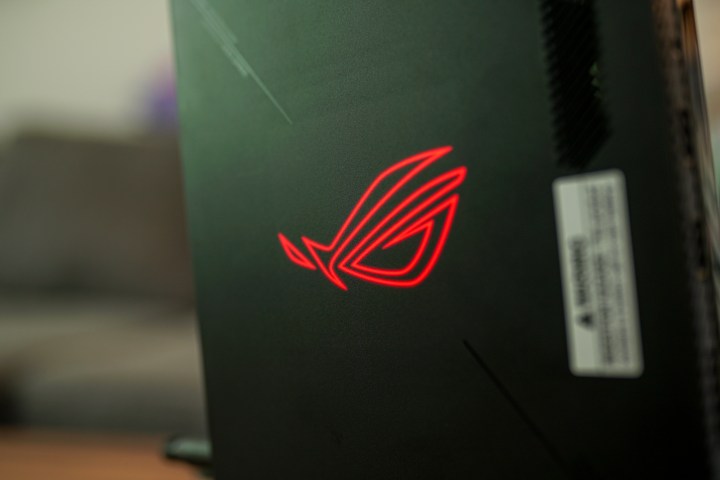 The ROG logo on the Asus ROG NUC 970.The illuminated ROG logo on the Asus ROG NUC 970.
The ROG logo on the Asus ROG NUC 970.The illuminated ROG logo on the Asus ROG NUC 970.
The ROG NUC 970 unmistakably belongs to the Republic of Gamers family. A red ROG logo illuminates the left side through smoky transparent plastic, reminiscent of previous NUC designs. Aggressive vent lines, an angular power button, and a prominent ROG badge on the front complete the gamer aesthetic. While design space is limited on a 2.5-liter black box, Asus has incorporated stylish touches wherever possible.
The device is remarkably compact and densely packed. The fully plastic shell feels slightly less robust than its internal hardware suggests. While the build quality is acceptable, handling the NUC 970 with care is recommended.
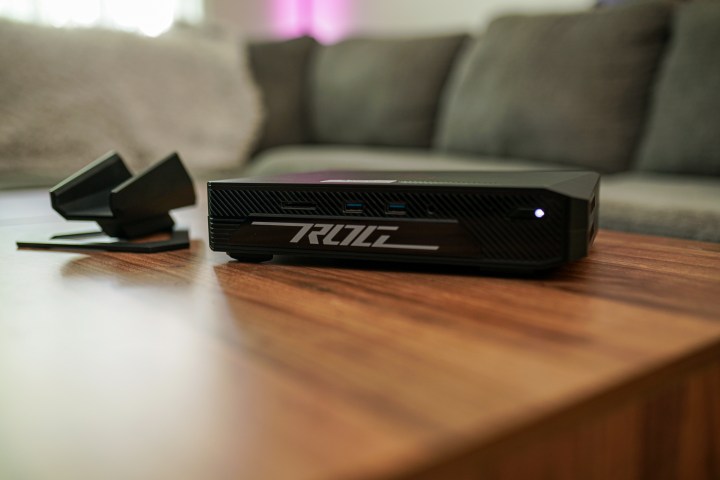 The Asus ROG NUC 970 sitting sideways on a table.The Asus ROG NUC 970 in its horizontal orientation.
The Asus ROG NUC 970 sitting sideways on a table.The Asus ROG NUC 970 in its horizontal orientation.
This shouldn’t be a major concern. The shell features four large rubber feet for horizontal placement, and Asus includes a sturdy metal stand for vertical orientation. The stand, which weighs almost as much as the NUC itself, has a thick rubber lining to secure the device. The vertical orientation increases the overall footprint. Fortunately, the NUC 970 looks more appealing horizontally.
Accessing the internals is relatively straightforward. A latch on the back unlocks the side panel, which slides off. Then, removing a screw on the back allows you to slide out a metal plate holding the side lighting design, similar to previous NUCs, allowing for logo customization. This reveals the RAM, storage, and wireless card.
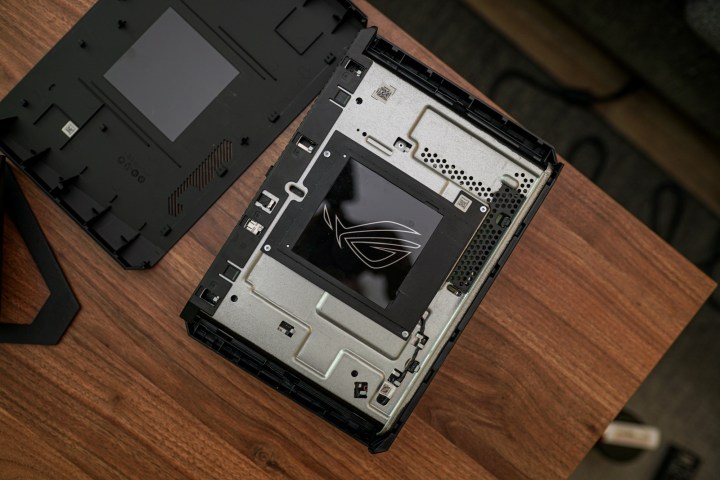 A metal panel on the side of the Asus ROG NUC 970.The removable metal panel covering the motherboard.
A metal panel on the side of the Asus ROG NUC 970.The removable metal panel covering the motherboard.
While opening the ROG NUC 970 is simple in theory, it proved challenging in practice. Sliding off the metal shield covering the motherboard was particularly difficult. The process felt precarious, and I accidentally dislodged the plastic back panel. With a little more force, I could have easily broken the plastic shell. Removing the shield became easier after a few attempts, but internal access shouldn’t be a frequent requirement. Once inside, the three NVMe slots and two SODIMM slots are readily accessible. Asus includes quick-release latches for the NVMe drives, making upgrades a breeze. I swapped the included SSD in about 30 seconds.
Performance
Given the ROG NUC 970’s use of laptop components, managing performance expectations is crucial. It won’t deliver the same level of performance as a desktop Core i9 CPU or RTX 4070 GPU. While I’ve included desktop comparisons for context, the true benchmarks are against laptops.
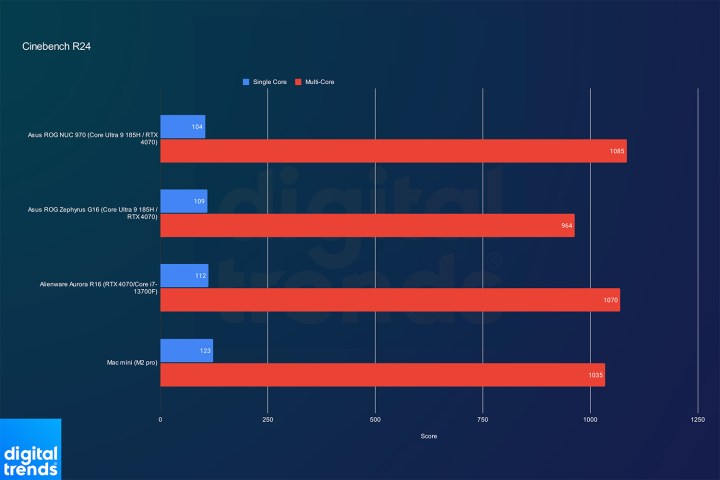 Performance of the Asus ROG NUC 970 in Cinebench.Cinebench R24 benchmark results.
Performance of the Asus ROG NUC 970 in Cinebench.Cinebench R24 benchmark results.
Asus appears to extract maximum performance from these laptop components. In Cinebench R24, the NUC 970 surpasses the Zephyrus G16 with the same CPU. It also outperforms the M2 Pro Mac mini in multi-core performance, while trailing slightly in single-core scores. Impressively, it matches the Alienware Aurora R16 equipped with a desktop Core i7-13700F, although that’s an older processor.
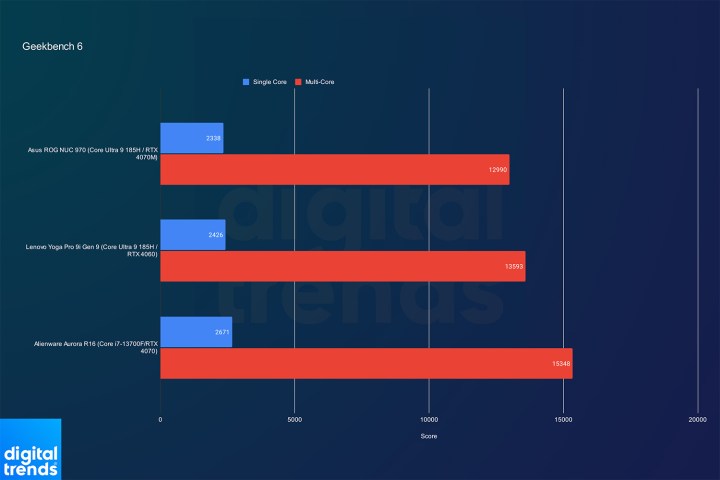 Performance of the Asus ROG NUC 970 in Geekbench.Geekbench 6 benchmark results.
Performance of the Asus ROG NUC 970 in Geekbench.Geekbench 6 benchmark results.
Geekbench 6 presents a slightly different picture. The ROG NUC 970 falls short of the Lenovo Yoga Pro 9i, which has the same processor. The comparison with the Alienware Aurora R16 is more revealing, with the Core Ultra 9 185H being outperformed in both single and multi-core performance. Despite maximizing component performance, the ROG NUC 970’s laptop-grade hardware ultimately limits its capabilities compared to larger desktops.
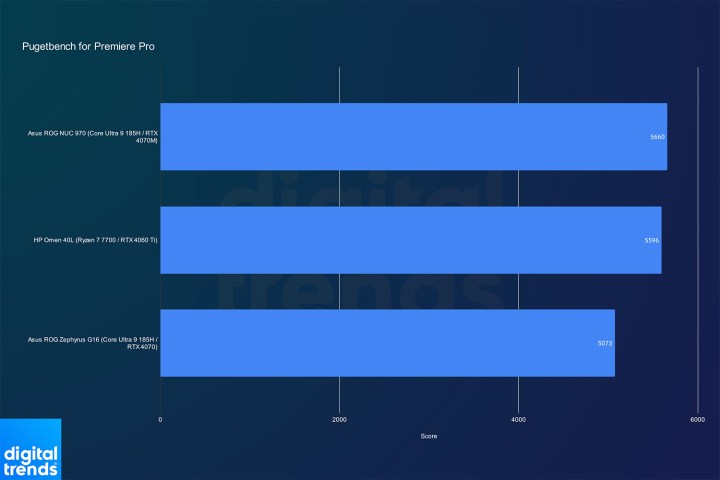 The Asus ROG NUC 970 performance in Adobe Premiere Pro.Adobe Premiere Pro benchmark results.
The Asus ROG NUC 970 performance in Adobe Premiere Pro.Adobe Premiere Pro benchmark results.
In real-world applications, the ROG NUC 970 performs well. It outpaces the Zephyrus G16 and essentially matches the HP Omen 40L desktop with a Ryzen 7 7700 and desktop RTX 4060 Ti in Premiere Pro.
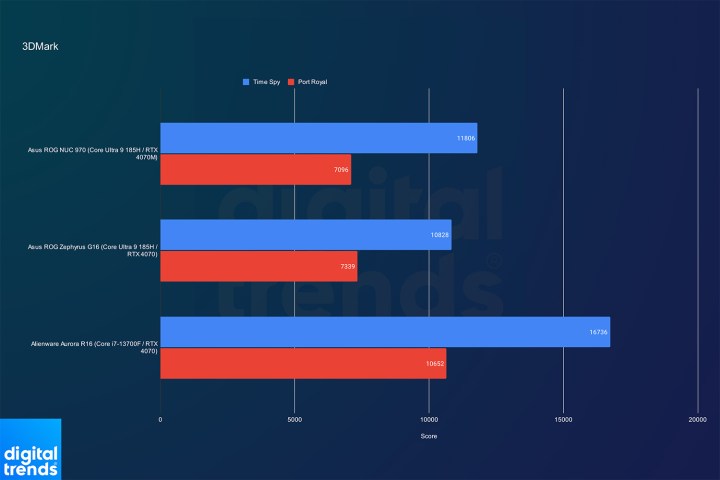 Asus ROG NUC 970 performance in 3DMark.3DMark benchmark results.
Asus ROG NUC 970 performance in 3DMark.3DMark benchmark results.
Being a gaming device, the ROG NUC 970 benefits from full power delivery to the RTX 4070, unlike thin gaming laptops. However, this doesn’t always translate to a significant performance advantage. In 3DMark, the NUC 970 slightly outperforms the Zephyrus G16 but is significantly overshadowed by the Alienware Aurora R16. This clearly demonstrates that the ROG NUC 970 performs more like a laptop than a desktop.
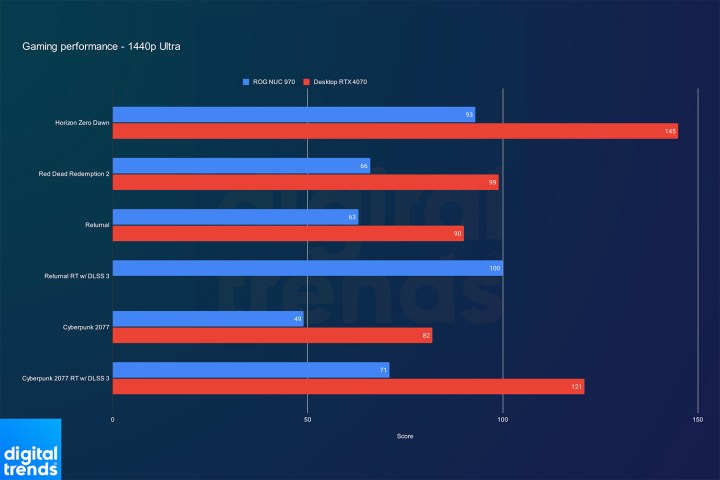 Gaming performance of the Asus ROG NUC 970 at 1440p.Gaming performance at 1440p resolution.
Gaming performance of the Asus ROG NUC 970 at 1440p.Gaming performance at 1440p resolution.
In actual gameplay, the mobile RTX 4070 delivers a respectable experience. In demanding games at 1440p, frame rates consistently exceed 60 fps. 4K gaming might even be achievable with DLSS 3 enabled in titles like Returnal. The comparison to a desktop RTX 4070 reinforces the mobile nature of the graphics performance.
The ROG NUC 970 performed as expected, considering its internal components. The primary concern is that buyers might anticipate desktop-class performance based on the NUC 970’s form factor. It’s a capable performer, but managing expectations regarding its laptop-grade hardware is essential.
Ports and Connectivity
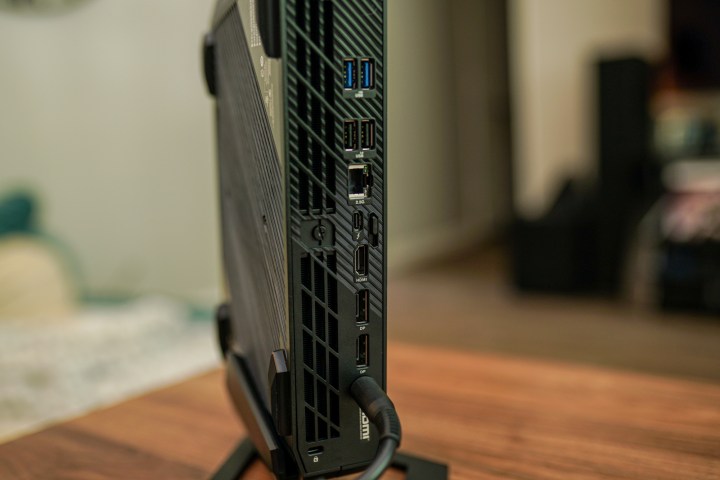 Ports on the Asus ROG NUC 970.Available ports on the Asus ROG NUC 970.
Ports on the Asus ROG NUC 970.Available ports on the Asus ROG NUC 970.
Despite using laptop components, the ROG NUC 970’s desktop design allows for a comprehensive selection of ports. The front panel houses two USB 3.2 Gen 2 ports, a full-sized SD card slot, and a headphone jack. The rear panel provides an HDMI 2.1 port, two DisplayPort 1.4a connections, a Thunderbolt 4 port, two USB 3.2 Gen 2 ports, two USB 2.0 ports, and a 2.5 Gigabit Ethernet port. An additional USB-C port and upgrading the USB 2.0 ports to a faster standard would be welcome additions, but the current selection is impressive.
Importantly, the NUC 970 utilizes an external power supply, a necessary compromise due to its size. The 330W adapter is bulky and heavy. While externalizing the power brick keeps the device itself compact, allocating space for the adapter is essential.
Wireless connectivity includes Wi-Fi 6E and Bluetooth 5.3, facilitated by an Intel wireless card. I encountered some initial wireless issues, resolved by reinstalling the driver. This shouldn’t be a widespread problem, and Asus provides a convenient one-click driver installer on their website. Preemptively downloading these drivers to a USB drive is recommended.
Should You Buy the Asus ROG NUC 970?
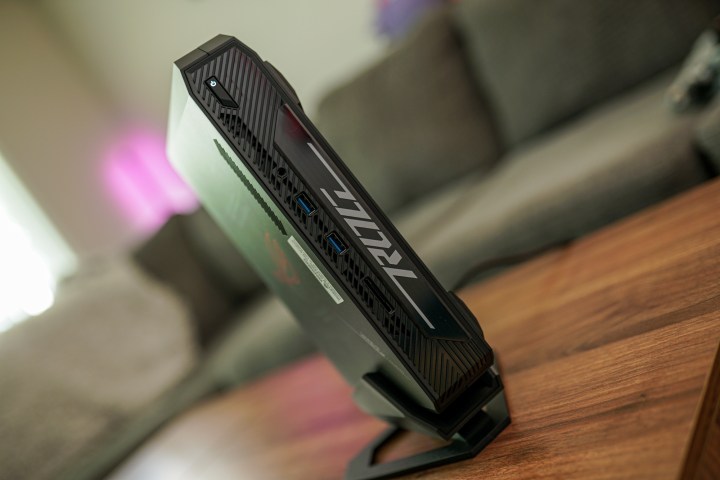 The Asus ROG 970 sitting on a coffee table.The Asus ROG NUC 970 in a living room setting.
The Asus ROG 970 sitting on a coffee table.The Asus ROG NUC 970 in a living room setting.
The ROG NUC 970 carves its own niche in the mini PC market, offering high performance in an incredibly small package. It caters to a specific audience, and within that niche, it’s an excellent choice. While it doesn’t offer the absolute best performance for its $2,200 price, its size, upgradability, and extensive connectivity make performance compromises understandable.
For those undecided, exploring alternatives is recommended. A laptop with similar components, such as the Zephyrus G16, provides comparable performance with added portability, often at a lower cost. A small form factor desktop might be larger, but it offers significantly more processing power.



